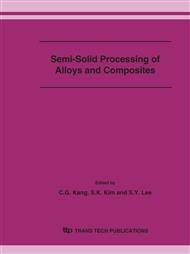p.159
p.163
p.167
p.173
p.177
p.181
p.185
p.189
p.193
Microstructure Control and Structure Analysis in the Semi-Solid State of Different Feedstock Materials for the Bearing Steel 100Cr6
Abstract:
The bearing steel 100Cr6 in the forged and hardened condition is of great importance in industrial use. Escaping the geometry restrictions of conventional forging, the application of semi-solid metalworking (SSM) offers significantly increased design freedom. Using conventionally available rolled feedstock material with carbide banding, however, results in a higher segregation tendency during thixoforging, and thus special attention was paid to the feedstock’s “quality”. To achieve a fine-grained, globular microstructure in the semi-solid state, castings with and without the addition of 100 ppm titanium were compared with the hot rolled material. With its inherent nitrogen Ti forms TiN particles, which reduce grain-growth in austenite. The results indicate that TiN precipitates strongly affect grain growth during solid state processing, but the grain size in the semi-solid state can only be influenced for short process times. Generally the cast feedstock materials possess smaller globulites in the semi-solid state compared to forgings, so that a reduction of the sponge effect and a minimization of the segregation in produced components are expected. Since the cast material already showed a fine-grained, globulitic microstructure, the use of TiN is not recommended because of the possible negative influence of TiN on the dynamic mechanical properties.
Info:
Periodical:
Pages:
177-180
Citation:
Online since:
October 2006
Price:
Сopyright:
© 2006 Trans Tech Publications Ltd. All Rights Reserved
Share:
Citation:


